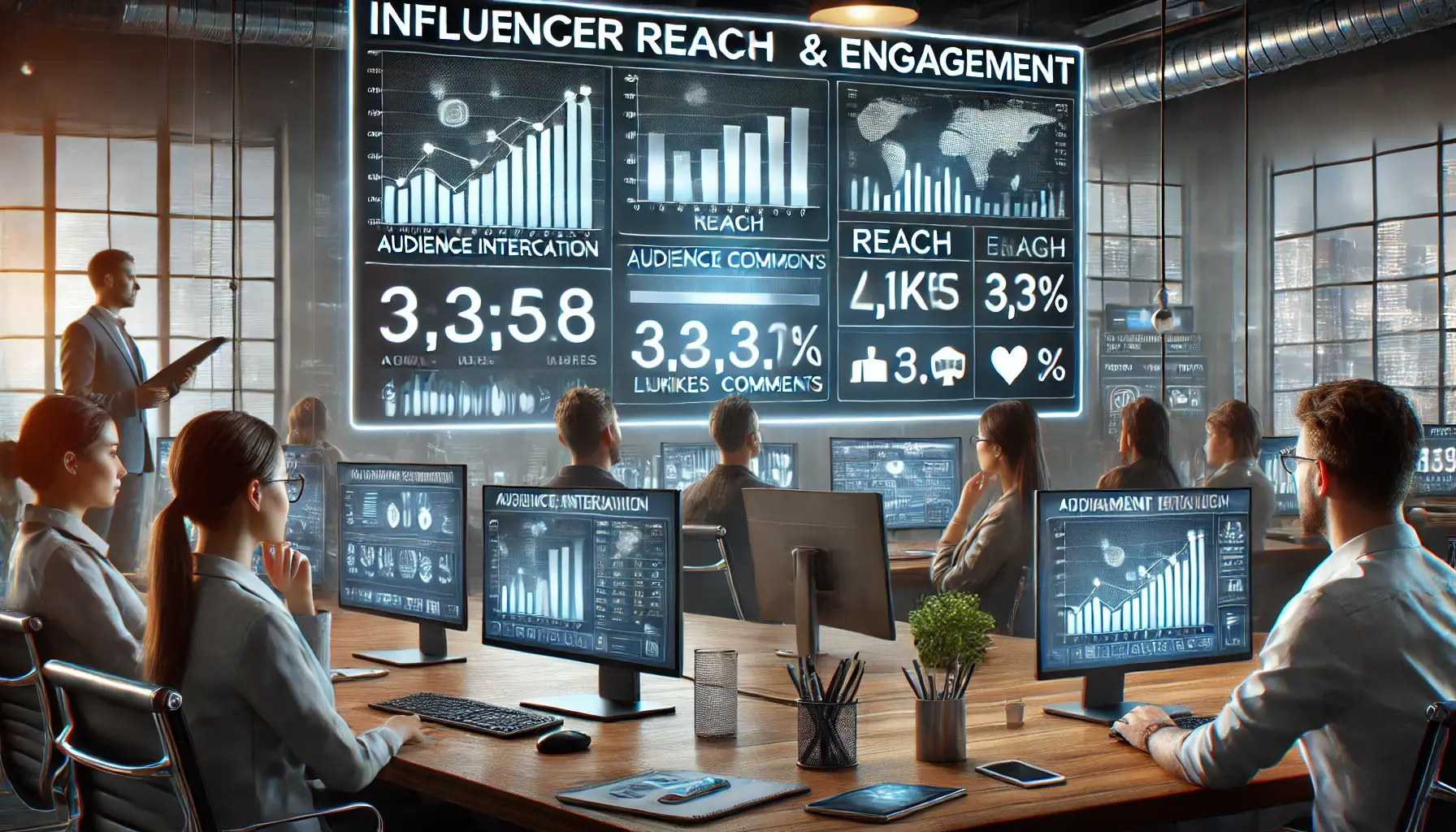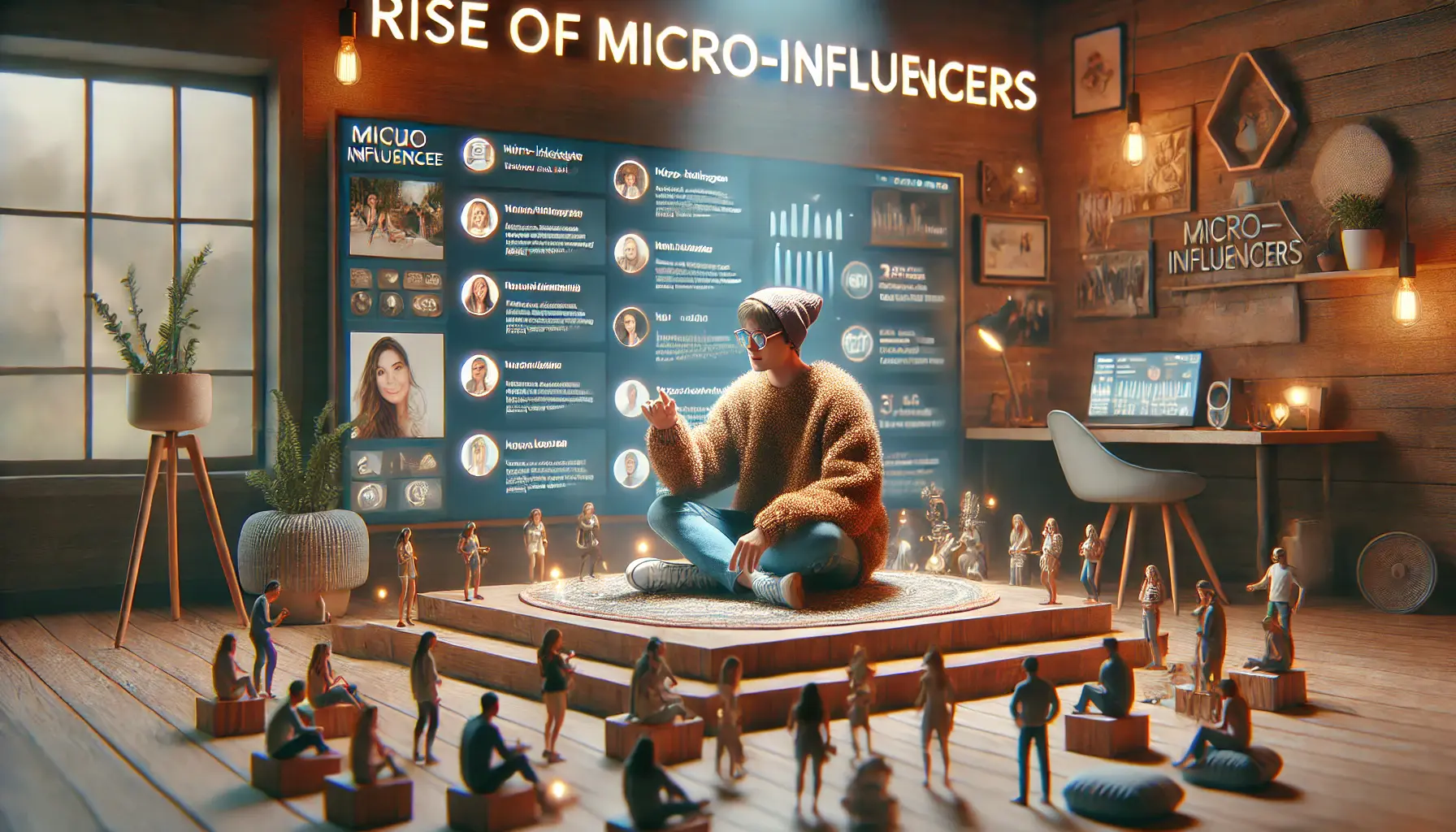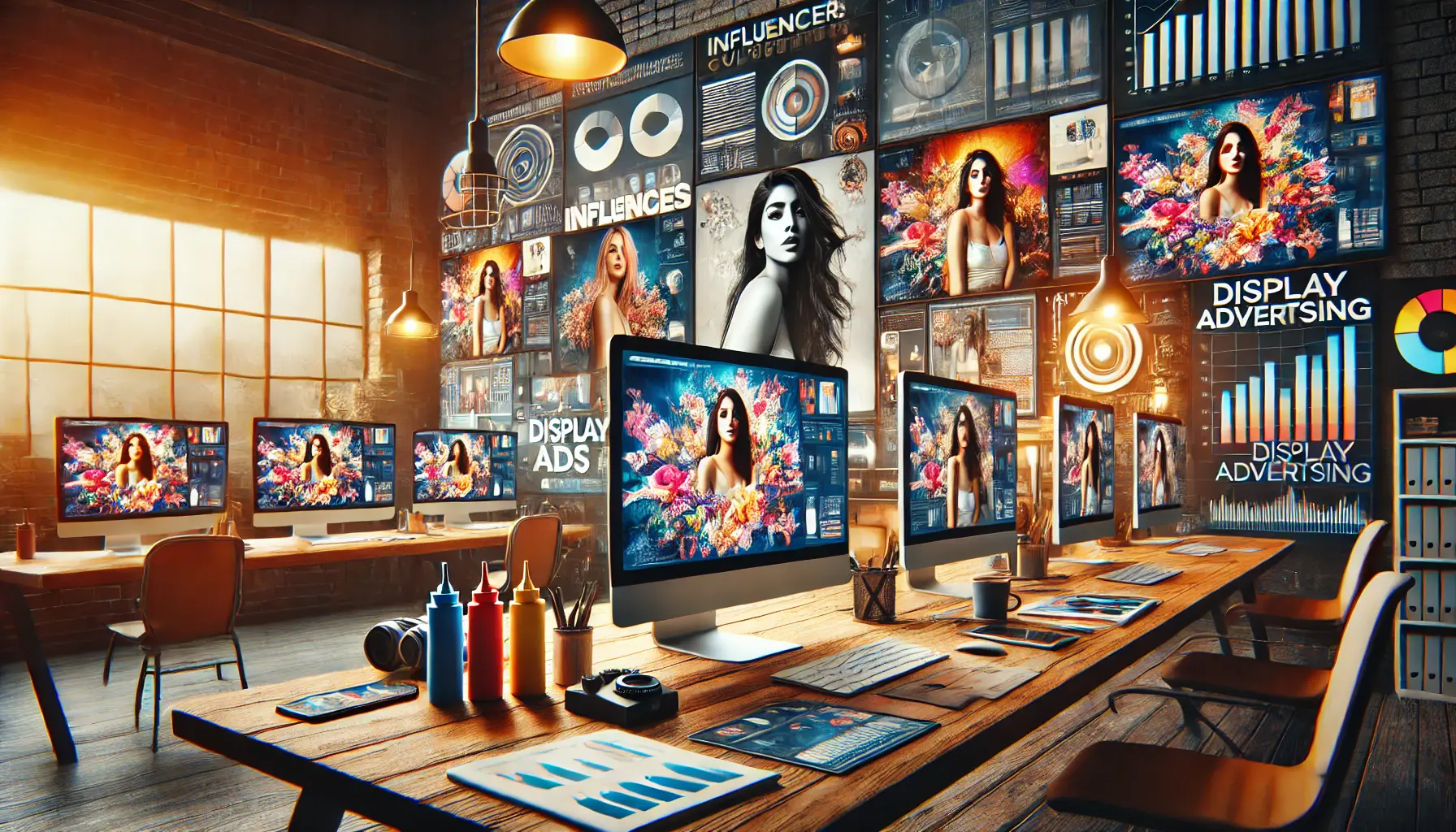In the fast-moving world of digital marketing, staying ahead requires creative strategies that strike a chord with your audience.
One such approach that has really gained momentum is the usage of influencer collaborations in display ads.
This combines the authenticityThe quality of being genuine or true. of influencers’ voices with the visual appeal of display advertising.
Whether it be increasing brand awareness, driving conversions, or building trust, collaborations with influencers can do it all, working for a wide range of goals.
In this article, we’ll dive deep into how influencer collaborations are revolutionizing display advertising, starting with an exploration of their impact on brand visibility.
If you’re ready to unlock the potential of influencers for your campaigns, read on and discover actionable insights that can transform your marketing efforts.
- The Power of Influencer Collaborations in Display Advertising
- Choosing the Right Influencers for Your Campaign
- Crafting Effective Display Ads with Influencers
- Tracking Performance Metrics for Influencer Ads
- Future Trends in Influencer Collaborations and Display Ads
- Conclusion: The Power of Influencer Collaborations in Display Ads
- Frequently Asked Questions About Influencer Collaborations in Display Ads
The Power of Influencer Collaborations in Display Advertising
Influencers have become pivotal in shaping how brands communicate with their audiences.
With their established trust and authenticity, influencers offer a unique advantage that traditional advertising methods often struggle to achieve.
When paired with display ads, this advantage is magnified, creating a synergyThe interaction or cooperation of two or more elements to produce a combined effect greater than the sum of their separate effects. that boosts campaign performance significantly.

The pivotal role of influencers in crafting impactful display ad campaigns.
Why Influencers Are Crucial for Display Ads
Influencers have that credibility and relatability that most brands lack.
People trust the opinions of influencers, and their endorsement will have much more effect than any generic advertisement.
Incorporating influencer collaborations into your display ads allows you to:
- Build instant trust: Audiences engage with ads more often because they feature familiar and trusted faces.
- Expand reach: Influencers often boast large and highly engaged followings, helping your ads reach a broader audience.
- Enhance relatability: Influencers present your products or services in a real-world context, making them more appealing.

The impact of influencers in amplifying brand visibility through digital engagement.
How Influencers Enhance Brand Visibility
Collaborating with influencers in display ads amplifies your brand’s visibility in several ways:
- Targeted exposure: Influencers’ audiences align closely with specific niches, ensuring your ads reach the right demographic.
- Increased engagement: Followers are more likely to interact with content featuring influencers they admire.
- Memorable impressions: Combining influencer familiarity with striking display ad visuals leaves a lasting impact on viewers.

Influencer collaborations across industries like fashion and technology, showcasing successful product promotions.
Case Studies: Successful Influencer Collaborations
Many brands have witnessed remarkable success by integrating influencer collaborations into their display ad strategies.
For instance:
- Fashion brands: Using influencers to showcase new collections in display ads has driven both online and in-store sales.
- Tech companies: Partnering with tech influencers for product launches has generated massive pre-orders.
- Fitness products: Collaborations with fitness influencers have created viral campaigns, significantly boosting brand awareness.
By understanding and leveraging the power of influencer collaborations, you can transform your display ad campaigns into highly effective marketing tools.
Influencer collaborations combine trust and authenticity, amplifying the effectiveness of display advertising through relatable and engaging content.

The process of selecting the right influencers based on audience fit and campaign goals.
Choosing the Right Influencers for Your Campaign
Finding the right influencers for your display ad campaign can make or break its success.
With the abundance of influencers across various platforms, selecting the ideal match for your brand requires a strategic approach.
The right influencers not only amplify your message but also ensure your campaign resonates authentically with the target audience.

The strategic process of identifying and analyzing a target audience for effective marketing campaigns.
Identifying Your Target Audience
Before selecting influencers, it’s crucial to have a clear understanding of your target audience.
Ask yourself questions like:
- Who are the consumers you’re trying to reach?
- What platforms do they spend the most time on?
- What type of content appeals to them?
By answering these questions, you can narrow down the list of influencers whose audience aligns with your own.
For example, if you’re targeting Gen Z, focusing on TikTok or Instagram influencers might yield better results than other platforms.

A digital marketing team evaluating influencer performance based on reach and engagement metrics.
Evaluating Influencer Reach and Engagement
While the number of followers a social media influencer has is important, it is not the only factor to consider.
In many cases, engagement ratesThe percentage of an audience interacting with content through likes, comments, shares, or clicks. are more valuable than raw numbers.
High engagement means that the followers of the influencer are interacting with the content provided, which increases the likelihood of your advertisements being noticed.
Key metrics to analyze include:
- Likes and Comments: Are followers interacting with the content?
- Shares: Are posts being shared, expanding their reach?
- Click-Through Rates: Are followers clicking on links or visiting promoted sites?
Tools like HypeAuditorA tool used to analyze the performance and authenticity of influencers., Social BladeA platform for tracking statistics and analytics of social media accounts., and BuzzSumoA tool for analyzing content performance and discovering influencer metrics. can help you assess an influencer’s performance and authenticity.

The process of selecting influencers whose content aligns with the brand’s values and message.
Matching Influencers with Your Brand’s Message
Collaborations are most effective when the influencer’s personal brand aligns with your business’s values and message.
This creates a seamless integration that feels genuine rather than forced.
To achieve this:
- Review their past collaborations and ensure they haven’t partnered with conflicting brands.
- Analyze their tone and content style to see if it matches your campaign’s goals.
- Communicate your expectations clearly to ensure both parties are on the same page.
Remember, a successful collaboration is not just about the numbers; it’s about finding an influencer who truly believes in your product or service and can communicate that enthusiasm to their audience with authenticity.
Indeed, choosing the right influencers may take time and research, but it’s well worth it.
A well-matched partnership can lead to higher engagement, improved brand perception, and better campaign outcomes.
Selecting influencers without understanding your audience risks low engagement and misalignment with brand values.

Collaborative efforts in crafting impactful display ads with influencers, focusing on creative strategy and visual design.
Crafting Effective Display Ads with Influencers
Once you’ve identified the right influencers for your campaign, the next step is crafting display ads that truly leverage their potential.
Influencer collaborations are most impactful when the content is engaging, visually appealing, and aligned with both your brand and the influencer’s style.
A strategic approach ensures that your ads not only capture attention but also drive meaningful results.

Collaborative brainstorming for content creation, emphasizing influencer-driven campaigns and authentic content.
Collaborative Content Creation Strategies
Collaboration with influencers should be a two-way process.
Engage them in the creation process to generate authentic and engaging content.
Here’s how you can make this happen:
- Brainstorm together: Work with the influencer to devise concepts that best fit your campaign objectives and their audience’s interests.
- Give creative freedom: Allow influencers to infuse their personal touch, as they understand their audience best.
- Set clear guidelines: Ensure the content reflects your brand’s values and messaging while maintaining authenticity.
When influencers are involved in the creative process, the resulting ads feel more genuine and resonate better with viewers.

A design team refining the visual elements of digital display ads to create effective and engaging messaging.
Best Practices for Visual Design and Messaging
The visual and messaging aspects of your display ads are critical in grabbing attention and conveying your message effectively.
To create standout ads:
- High-quality visuals: Work with influencers to ensure that images or videos are shot professionally and optimized for each platform.
- Highlight the influencer: Make sure the influencer is front and center in your ad to capitalize on their recognition and trust with the audience.
- Craft concise messages: Keep text short and impactful, focusing on key benefits or calls-to-action.
- Ensure brand consistency: Incorporate your brand’s logo, colors, and fonts to maintain a cohesive identity.
Combining striking visuals with concise and engaging messaging creates ads that are both memorable and actionable.

A marketing team optimizing digital ads by reviewing performance data and making adjustments for maximum impact.
Optimizing Ads for Maximum Impact
Even the most well-crafted display ads need to be optimized for performance.
By fine-tuning various elements, you can ensure your ads achieve maximum impact.
Key optimization strategies include:
- A/B Testing: Run tests by changing visuals, headlines, and calls-to-action to see what works most effectively with your audience.
- Platform-specific adjustments: Adapt your ads according to the specifications and user behavior on different platforms, whether it’s Instagram, Facebook, or YouTube.
- Performance tracking: Track KPIs such as click-through rates, conversions, and engagement to measure success and make data-driven improvements.
Continuous optimization ensures that your ads remain effective and relevant for the entire duration of the campaign.
The creation of effective display ads with influencer collaborations is based on creativity, strategy, and optimization.
Authentic collaboration, compelling design, and tracking performance will help you create highly effective influencer partnerships.
Involve influencers in content creation to ensure authenticity and resonate with their audience effectively.
A marketing team tracking performance metrics to optimize influencer ad campaigns.
Tracking Performance Metrics for Influencer Ads
After crafting your display ads with influencers, it’s essential to track their performance.
Monitoring key metrics ensures that your campaign is meeting its objectives and provides insights for optimization.
By analyzing data effectively, you can refine your strategies to maximize return on investment (ROIReturn on Investment, a measure of the profitability of an investment relative to its cost.).

A team analyzing key metrics to evaluate the success of a digital marketing campaign.
Key Metrics to Measure Campaign Success
Tracking the right metrics is crucial to understanding the impact of your influencer collaborations.
Focus on these key performance indicators (KPIs):
- Click-Through Rate (CTR): Measures how many people clicked on your ad compared to how many saw it, indicating its effectiveness in driving traffic.
- Engagement Rate: Tracks likes, comments, and shares on influencer-related content, showing how well the audience is interacting.
- Conversion Rate: Explains the number of viewers who have taken the desired action, such as purchasing a product or signing up for a newsletter.
- Impressions: Shows how often your ad was viewed, indicating the reach of your ad.
- Cost Per Click (CPC): Assists in assessing campaign cost-efficiency by showing how much you pay to get one click.
By focusing on these metrics, you can assess both the qualitative and quantitative impact of your ads.

undefined
Using Analytics Tools to Monitor Engagement
Leverage analytics tools to gain deeper insights into your campaign’s performance.
These tools provide data visualization and help identify trends:
- Google Analytics: Tracks website traffic, user behavior, and conversions driven by your ads.
- Social Media Insights: Platforms like Instagram and Facebook provide built-in analytics for measuring engagement and reach.
- Third-Party Tools: Use tools like Hootsuite, Sprout Social, or HubSpot for more comprehensive campaign tracking.
These resources help streamline data collection and enable informed decision-making.

A marketing team adjusting their strategies based on performance data to optimize ad campaigns.
Adjusting Strategies Based on Performance Data
Performance data analysis isn’t just about understanding results—it’s about taking actionable steps to improve.
Here’s how you can use the insights to refine your campaign:
- Optimize poor-performing ads: Identify ads with low engagement or CTR and modify visuals, messaging, or calls-to-action.
- Allocate budget wisely: Invest more in the top influencers or platforms driving great ROI.
- Test new approaches: Experiment with different ad formats or content styles to discover what resonates most with your audience.
Regularly revisiting and adjusting your strategies ensures that your campaigns remain effective and relevant over time.
By consistently tracking and analyzing performance metrics, you can unlock the full potential of your influencer collaborations, delivering campaigns that not only achieve their goals but also set the stage for future success.
Use tools like Google Analytics and social media insights to refine campaign strategies based on measurable data.

A team discussing the future of influencer collaborations, with holographic displays of social media metrics and AI-driven marketing tools.
Future Trends in Influencer Collaborations and Display Ads
As digital marketing evolves, the landscape of influencer collaborations in display advertising is shifting rapidly.
With the rise of new technologies, changing consumer behaviors, and emerging platforms, brands must adapt to stay ahead of the curve.
Here are the key trends shaping the future of influencer partnerships in display ads.

The growing influence of micro-influencers, emphasizing authenticity and strong community connections in advertising.
The Rise of Micro-Influencers in Advertising
Micro-influencers are the new popular kids on the block in advertising, with smaller but highly engaged audiences.
Unlike mega-influencers, micro-influencers often maintain a closer, more authentic connection with their followers, leading to higher engagement rates.
Studies have shown that micro-influencers achieve an average engagement rate 60% higher than that of larger influencers.
For brands, this means:
- More authentic connections: Micro-influencers are seen as more trustworthy, leading to more genuine engagement.
- Higher conversion rates: Their followers are more likely to act on recommendations due to the personal nature of the relationship.
- Cost-effective campaigns: Micro-influencers are typically more affordable than larger influencers, making them ideal for brands with smaller budgets.

Using AI technology to optimize influencer selection and campaign strategies based on data-driven insights.
AI-Powered Influencer Selection and Campaigns
AI changes the game in influencer marketing.
Now, AIArtificial Intelligence, the simulation of human intelligence processes by machines, especially computer systems.-driven systems are able to analyze huge databases for the most relevant matches between a brand’s target audience, campaign objectives, and style.
These tools help brands:
- Automation of Influencer Discovery: AI-powered tools can scan influencer databases for the right fit with specific criteria related to audience demographics and engagement patterns.
- Predict campaign performance: AI can analyze past data to forecast how well an influencer collaboration will perform, helping brands optimize their choices.
- Enhance targeting: AI enables more precise targeting, ensuring that the right influencers reach the right audience with the most relevant content.

Discussing ethical and sustainable influencer collaborations to align with brand values.
Sustainability and Ethical Collaborations
Today’s consumer is ever so conscious about sustainability and ethical practices; this reflects very much in the way brands go about influencer collaborations.
Many brands are now shifting their focus to align themselves with influencers promoting environmental and social causes.
To stay ahead, brands should:
- Partner with cause-driven influencers: Find influencers known for supporting sustainability, diversity, and ethical practices as a way to align your brand with these values.
- Highlight ethical practices: Showcase how your brand is making a positive impact through sustainable sourcing, fair labor practices, or community initiatives.
- Build long-term partnerships: Instead of one-off promotions, partner with influencers who believe in your mission, creating long-term, valuable relationships.
The focus on sustainability and ethics isn’t just a trend, but a response to the increasing demand for transparency in business practices.
Consumers are more likely to engage with and support brands that reflect their values.
The future of influencer collaborations in display ads is full of opportunities for brands that are ready to embrace new technologies, ethical practices, and innovative strategies.
By staying informed and adaptable, you can harness these trends to create more impactful, authentic, and successful influencer marketing campaigns.
Embrace micro-influencers, AI-driven campaigns, and sustainability to align with evolving consumer preferences and trends.

undefined
Conclusion: The Power of Influencer Collaborations in Display Ads
In conclusion, influencer collaborations are transforming the landscape of digital advertising, especially in display ads.
By tapping into the trust, authenticity, and relatability that influencers bring, brands can build more engaging, effective, and impactful campaigns.
As consumer behavior shifts and technology advances, it’s essential for businesses to stay ahead of the curve and make the most of these collaborations.

Reviewing the key takeaways from influencer collaborations and their impact on digital marketing.
Key Takeaways from Influencer Collaborations
As you consider incorporating influencer collaborations into your display ads, here are some key insights to remember:
- Authenticity matters: Influencers who align with your brand values can create more genuine and engaging content, leading to higher engagement rates and trust.
- Micro-influencers are rising: With their highly engaged audiences, micro-influencers provide more affordable yet effective opportunities for brands looking for targeted impact.
- AI is reshaping influencer selection: AI-powered tools are streamlining influencer discovery and campaign optimization, ensuring more precise targeting and better results.
- Sustainability is a growing concern: Consumers expect brands to embrace sustainability and ethical practices. Partnering with cause-driven influencers is a strategic way to resonate with your audience’s values.

The future of influencer collaborations, highlighted by emerging technologies and evolving digital marketing strategies.
Looking Ahead: The Future of Influencer Collaborations
The future of influencer collaborations in display ads appears bright and will further be driven by rapid advances in technology, shifts in the preferences of modern-day consumers, and an increasing urge for authenticity.
The next wave will concentrate on:
- Enhanced personalization: Using data-driven insights for deeper personalization in your influencer campaigns for more effectiveness.
- Long-term partnerships: Moving beyond one-time collaborations to build lasting relationships with influencers who genuinely believe in your brand.
- Cross-platform campaigns: Expanding influencer marketing efforts across multiple platforms to reach broader and more diverse audiences.
By being agile and innovative with influencer collaborations, brands can create actual value and success for their display ad campaigns.
Whether an enterprise or a small company, influencer collaborations offer invaluable opportunities to bring in more views, gain brand trust, and ultimately hike your ROI.
Leveraging influencers authentically ensures impactful campaigns, higher engagement, and greater ROI.

undefined
Your campaigns can be managed by an agency specialized in Google Ads, check out our service page.
Frequently Asked Questions About Influencer Collaborations in Display Ads
In this section, we address some of the most common questions about using influencer collaborations in display ads.
These insights will help you navigate the key considerations for successful campaigns.
Influencers add credibility and trust to display ads, driving higher engagement and boosting conversions by connecting with their audience on a personal level.
Their endorsement makes ads feel more authentic.
Micro-influencers have highly engaged, niche audiences, making them cost-effective for brands.
Their authenticity leads to stronger connections, better engagement, and higher conversion rates compared to larger influencers.
Track key metrics like click-through rates, engagement rates, conversion rates, and impressionsThe total number of times an ad or content is displayed to viewers..
These metrics help evaluate the effectiveness of your influencer collaborations and adjust strategies for better performance.
AI-powered tools help identify influencers who match your brand’s goals and target audience.
They enable precise targeting, campaign performance prediction, and optimized collaboration strategies based on past data.
Consumers are increasingly drawn to brands that embrace sustainability.
Partnering with influencers who promote environmental or social causes helps align your brand with ethical values, fostering trust and deeper connections.
Yes, small businesses can benefit greatly from influencer collaborations, especially with micro-influencers.
These partnerships provide cost-effective ways to reach a targeted audience and generate engagement without a large budget.
It depends on your brand’s target audience.
Micro-influencers are great for niche markets, while larger influencers work better for widespread brand awareness.
Choose based on your goals and audience alignment.
Clear communication, aligning brand values, setting measurable goals, and choosing the right influencers are key to ensuring successful collaborations.
Regularly track performance and adjust strategies as needed for optimal results.
Popular platforms include Instagram, Facebook, and YouTube.
These platforms offer robust targeting features, high engagement potential, and various ad formats, making them ideal for influencer display ads.













